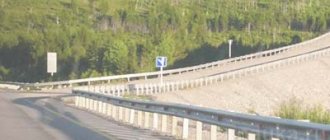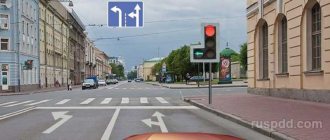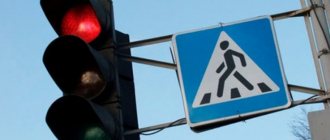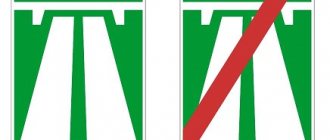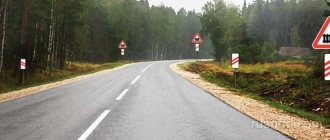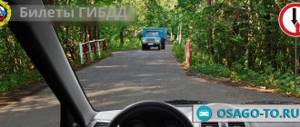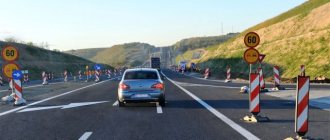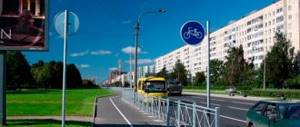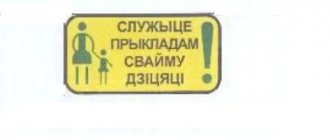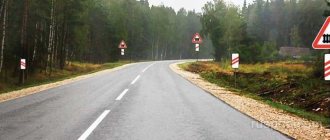4.1.1 Driving straight
Sign 4.1.1 informs about progress according to the arrow pointer (straight ahead). The symbol is relevant on streets with heavy traffic, where even a slight maneuverability of transport can lead to an emergency situation. In addition to this, traffic is explicitly prescribed on narrow roads to avoid congestion.
The functioning of the sign has the following features:
- does not prohibit reversing;
- allows entry into courtyards;
- installed before the fork;
- relevant only for the first intersection;
- does not affect the movement of route transport.
The prohibition of turning left and the absence of intersections of oncoming traffic increases the throughput of the selected section of the route.
Non-alternative signs
Sign 4.1.2 “Move to the right” indicates movement along the path prescribed by the arrow (to the right).
For example, gas stations are equipped with this symbol to ensure the safe movement of a car entering busy highways and highways. The functioning of the arrow contains nuances:
- You should turn right from the far right lane of the road.
- The symbol is installed before the intersection.
- Action - only at the first fork in the road.
- Not required for route transport.
The last point is especially worth remembering for inexperienced drivers who are repeating the maneuvers of the vehicle in front. Such imitation constitutes a gross offense and a danger of causing an accident. The fine for ignoring a mandatory symbol is set at 1,000 – 1,500 rubles.
Signpost 4.1.3 “Move to the left” determines the route of movement of the vehicle according to the image of the arrow (to the left). The symbol is mounted before the fork in the road and loses its force immediately after it. You should know that a left turn maneuver does not exclude a U-turn.
Sign 4.2.1 “Avoiding an obstacle on the right” gives an idea of how to go around an obstacle (on the right).
The prescriptive nature of the symbol helps to stabilize the road situation when:
- carrying out repair or cleaning work;
- activation of the dividing strip;
- the appearance of a safety island and other things.
If it is possible to go around an obstacle on the left, the driver is not recommended to do this in order to avoid an accident and a fine.
The symbol operates in the area where an object is located that impedes movement. After passing the obstacle, you should return to your lane and drive as usual. Typically, motorists try to avoid obstacles on the right without leaving their lane. But sometimes conditions arise that prevent safe detour. In these cases, the solution to the problem of passing the obstacle is to install the sign 4.2.2 “Avoiding the obstacle on the left.”
The symbol instructs you to go around obstacles on the left edge; accordingly, if it is possible to go around them to the right, this should not be done.
Often, the symbol is equipped with vehicles of municipal and road services responsible for the improvement of streets: repair and cleaning activities, watering of plantings along highways and streets. Sometimes the prescription contradicts the markings, represented by a solid or double solid line. Then one must adhere to the principle of advantage, that is, follow the instructions of the symbol.
The designation “Detour on the left” does not give privileges to the driver in front of vehicles traveling on the opposite path.
Other signs
In addition to the usual symbols, there are signs that carry special instructions:
- speed bump;
- pedestrian crossing (zebra crossing);
- bus stop;
- public transport lane;
- One Way.
Other signs are less common, but experienced drivers know them all.
For safe movement, signs of other groups are also used:
- warning signs;
- signs that indicate priority;
- prohibition and restriction signs;
- information signs;
- service signs.
Each group is described in detail in the traffic rules.
Alternative signs
There are several signs that provide for variability of choice:
- Symbol 4.1.4 “Move straight or right” determines the course according to the location of the arrows on the sign (straight or right). You must turn right, keeping to the right lane of the highway. The pointer is mounted before the upcoming branching path and is active exclusively on it. The fine for non-compliance with the instructions is 1,000 - 1,500 rubles.
- Pointer 4.1.5 “Move straight or left” sets the vector of movement according to the configuration of the arrows (straight or left). The designation is mounted to the nearest fork and has meaning only for it. The regulation does not apply to route vehicles.
- Sign 4.1.6 “Moving right or left” allows you to choose a route suggested by a combination of arrows (right and left). The rule can be ignored by route vehicles. The symbol can be found before the start of the intersection and followed exclusively at the first fork in the paths. So, signs 4.1.1 - 4.1.6 do not affect the movement of route transport. Signs 4.1.3, 4.1.5, 4.1.6 do not prohibit turning.
- Sign 4.2.3 “Avoiding an obstacle on the right or left” gives a choice of two lines to overcome the obstacle. To avoid getting into the opposite flow, it is preferable to go around the obstacle on the right.
The absence of markings 4.2.1, 4.2.2, 4.2.3 is supplemented by clause 9.12 of the traffic rules, which states: “On two-way roads in the absence of a dividing strip, traffic islands, bollards and elements of road structures (supports of bridges, overpasses, etc.) located on the middle of the roadway, the driver must pass on the right unless signs and markings indicate otherwise.”
Direction signs
Prescriptive road signs that coordinate movement are similar. They are depicted as vectors, pointers, and affect all types of transport that are found on the roads. The only exception is public transport. If he is moving along an agreed route, and such a sign is encountered on his way, the driver has the right to ignore these instructions and continue to adhere to the given route.
Signs from the group that regulates the direction are installed in front of the road intersection. Their area of influence ends after turning. The “go straight ahead” sign is unique.
Go straight
The sign only opens the way forward. It is installed in different places:
- At the beginning of the crossroads . The sign is valid no further than the first turn. If an intersection includes more than one intersection, the sign loses its validity at all subsequent intersections.
- After suppression . The sign influences the entire length of the path, and ends its influence after the next intersection.
There are concessions to the restriction.
The sign behind the intersection allows you to enter the courtyards on the right.
Movement to the right
Indicates the direction of movement to the right.
Driving left
Indicates the direction of movement to the left.
Driving straight and right
When you encounter this sign, you can move straight or to the right.
Driving straight and left
If you see the sign, you can drive straight, left, or make a left turn.
Movement right and left
If you find a sign - turn right or left (or turn around).
Roundabout Circulation
Sign 4.3 “Roundabout” notifies the beginning of a traffic circle:
- when entering the ring, you must slow down the pace of movement;
- movement around the ring occurs exclusively counterclockwise;
- a turn is performed after driving a full circle;
- before the beginning of the roundabout, in addition to symbol 4.3, there are often signs 2.4 “Give way” or 2.5 “Driving without stopping is prohibited”;
- on a ring equipped with traffic lights, participants move according to the permitting signals.
A roundabout looks safer than a traditional one due to the lack of direct intersection of traffic flows. However, accidents happen here too. This happens, first of all, due to ignorance of the principle: the ring is almost always the main road. Some motorists, when entering the roundabout, believe that traffic moving in a circle should let them through, because they are an obstacle to it on the right.
Approaching a roundabout requires the driver to adhere to the posted speed limit, evaluate the symbols present, and follow the traffic rules around the roundabout.
Fines for violating signs
The fines for mandatory traffic signs are:
- at 500 rub. for cases not provided for in other sections 12.16;
- for part 2:
Turning left or making a U-turn in violation of the requirements prescribed by road signs or road markings shall entail the imposition of an administrative fine in the amount of one thousand to one thousand five hundred rubles.
- for part 3:
Driving in the opposite direction on a one-way road entails an administrative fine in the amount of five thousand rubles or deprivation of the right to drive vehicles for a period of four to six months.
If the offense is repeated, the driver will lose his driving license for a year.
- for part 4:
Failure to comply with the requirements prescribed by road signs or road markings prohibiting the stopping or parking of vehicles, except for the case provided for in Part 5 of this article, shall entail the imposition of an administrative fine in the amount of one thousand five hundred rubles.
In Moscow and St. Petersburg, a motorist will pay 3,000 rubles.
- If a truck driver breaks the rules, he will pay 500 rubles. And if he commits an offense in the capital or St. Petersburg - 5,000 rubles.
Mandatory traffic signs are no less strict than prohibitive ones. And it is just as important to comply with their requirements. Otherwise, it’s easy to get into an accident.
Bike Lane
Sign 4.4.1 “Bicycle path” notifies the beginning of an individual route for cyclists.
The highway is equipped with a lane for two-wheeled vehicles with a maximum speed of no higher than 40 km/h. The designation is mounted:
- to the right of the path, when the demarcation is represented by green spaces and other objects;
- above the track together with the designation 8.14, when the border is marking 1.1.
After forks with highways and alternative routes, the symbol is duplicated.
Sign 4.4.2 “End of the bicycle path” notifies the end of one mode of movement and the beginning of the next. Now cyclists will have to travel on the road along with vehicles. They have to be extremely careful and follow the traffic rules regulating the designated order of movement.
The symbol is installed before the end of the bicycle path or lane.
Mandatory traffic signs
Mandatory signs are specially designed images applied to a base established in accordance with GOST 12.4.026-2001.
The shape of the sign is round. The main signal color is blue. These signs prescribe (that is, indicate) drivers and pedestrians how to move on the roads. They have a round shape and a blue background. It is especially important for schoolchildren to know two signs - “Pedestrian path” and “Bicycle path”.
Prescriptive signs prescribe, that is, indicate to drivers and pedestrians how traffic on the roads should be carried out
The “Pedestrian Path” sign serves to designate paths intended for pedestrians. Today, in many cities, entire streets and neighborhoods are appearing where traffic is prohibited and only pedestrians can move. Outside the city, such pedestrian paths are located along highways. Pedestrians should know: where such a sign hangs, the movement of any vehicle is prohibited.
The “Bicycle Path” sign serves to designate paths on which only bicycles or mopeds can be ridden. Other vehicles are prohibited from driving on them. Pedestrians can walk on such paths only when there is no sidewalk or pedestrian path on the road.
The remaining mandatory signs are intended for drivers. They indicate the directions in which vehicle movement is permitted.
4.5.1 Pedestrian path
Sign 4.5.1 indicates a section of the route reserved for pedestrian participants. In the field of operation of the symbol, movement and parking of any transport are excluded.
However, the requirement has a number of nuances:
- Vehicles may enter the territory to deliver goods to stores located here. But first, the driver must make sure that there are no other ways to access the store. The driver is obliged to move at a minimum speed, choosing the shortest route through the territory, and also respect the safety of pedestrians.
- Movement in the pedestrian zone is permitted for vehicles of municipal and road maintenance departments operating on this section of the road.
- Cyclists, moped and scooter drivers are allowed to move along the lane after getting off their vehicles.
The symbol is active from the mount point until the fork is overcome.
Mandatory signs in traffic
Names of mandatory signs:
- sign 4.1 “move straight ahead”;
- sign 4.2 “movement to the right”;
- sign 4.3 “movement to the left”;
- sign 4.4 “move straight or to the right”;
- sign 4.5 “move straight ahead or to the left”;
- sign 4.6 “movement to the right or to the left.” Movement only in the directions indicated by arrows on signs 4.1-4.6;
- sign 4.7 “ detour around obstacles on the right side”;
- sign 4.8 “ detour around obstacles on the left side.” Detour only from the side shown by the arrow on signs 4.7 and 4.8;
- sign 4.9 “detour around obstacles on the right or left side”;
- sign 4.10 “roundabout”. Requires going around the flower bed (central island) in the direction shown by the arrows at the roundabout;
- sign 4.11 “passenger car traffic”. Only passenger cars, buses, motorcycles, route vehicles and trucks with a permissible maximum weight not exceeding 3.5 tons are allowed;
- sign 4.12 “path for cyclists”. Movement only by bicycles. If there is no sidewalk or pedestrian path, pedestrian traffic is also allowed;
- sign 4.13 “path for pedestrians”. Pedestrian traffic only;
- sign 4.14 “ path for pedestrians and cyclists”. Movement of pedestrians and cyclists;
- sign 4.15 “path for riders”. Movement of riders only;
- sign 4.16 “minimum speed limit”. Movement at a speed no less than that indicated on the sign, but no greater than that provided for in paragraphs 12.4-12.7 of these Rules;
- sign 4.17 “end of minimum speed limit”.
Signs 4.3, 4.5 and 4.6 also allow vehicles to turn around.
Signs 4.3, 4.5 and 4.6 also allow vehicles to turn around
Signs 4.1-4.6 do not apply to vehicles moving along established routes. The effect of signs 4.1-4.6 extends to the intersection of roadways in front of which they are installed.
Sign 4.1, installed at the beginning of the road or behind an intersection, applies to the section of the road to the nearest intersection. The sign does not prohibit turning to the right into courtyards and other areas adjacent to the road.
Sign 4.11 does not apply to vehicles that serve citizens or belong to citizens who live or work in the designated zone, as well as to vehicles that serve enterprises located in this zone. In such cases, vehicles must enter and exit the designated area at the nearest intersection to their destination.
4.5.2 Pedestrian and bicycle path with combined traffic
Symbol 4.5.2 regulates the movement of pedestrians and bicycle owners along the same line.
The space is also used by owners of mopeds and scooters, since their vehicles have a travel speed below 40 km/h. There is no place for vehicles on the territory of the mandatory sign, except for:
- Vehicles delivering goods to objects in the area where the sign is active (if there are no other access routes);
- special vehicles of various services.
The territory of symbol activity extends from the installation point to the next fork.
Sign 4.5.3 “End of pedestrian and cycle path with combined traffic” informs pedestrians and bicycle owners about the end of a special section and the beginning of a different route plan. Participants should exercise caution when planning and structuring travel routes.
The installation of the symbol takes place on the territory where the general movement ends.
Signs 4.5.4 and 4.5.5 separate the paths for pedestrians and cyclists in the same area. The symbolism tells which row the participants should take. The rows are broken up by a border, lawn or markings.
Signs 4.5.4 and 4.5.5 regulate the end of the previous mode of movement of pedestrians and cyclists. From this moment on, they will have to double their attentiveness and caution, thinking through ways of a safe route.
The symbols are mounted at the end point of the bicycle pedestrian section.
What do pedestrians and cyclists need to know?
| Sign | Description |
Signs 4.4.1 Cycle path and 4.4.2 End of cycle path | They indicate, respectively, the beginning and end of the section on which you can ride a bicycle. |
Sign 4.5.1 Pedestrian path | They mark an area where you can only walk. |
Signs 4.5.2 Pedestrian and bicycle path with combined traffic (cycle and pedestrian path with combined traffic) and 4.5.4 End of pedestrian and bicycle path with combined traffic (end of bicycle and pedestrian path with combined traffic) | They mark the beginning and end of the road, along which you can travel on foot or by bicycle, at your own discretion. |
Signs 4.5.4 and 4.5.5 Segregated pedestrian and cycle path, as well as signs 4.5.6 and 4.5.7 End of segregated pedestrian and cycle path (end of segregated cycle and pedestrian path) | They mark the beginning and end of the bicycle and pedestrian road, respectively, in a separate mode - pedestrians in one lane, cyclists in the other. |
Bicycle and pedestrian signs are a whole family, so it’s worth looking at how they all work at once.
There are special bicycle and pedestrian paths
Their purpose is easy to understand: they regulate the movement of pedestrians and cyclists. Any of these signs is valid until the corresponding sign, which will cancel its effect, or until the nearest intersection of the path of any option with the highway.
A vehicle driver needs to know little about the signs regulating bicycle and pedestrian traffic: only that he must under no circumstances drive onto the road marked by them. This rule applies even to the driver of such an “open” and compact vehicle as a motorcycle or moped.
Well, pp. 9.9, 24.7 of the traffic rules states that bicycle paths are closed to mopeds. Designed for it:
- right edge of the roadway;
- roadside;
- a bicycle lane marked with a sign and markings.
Bike and pedestrian paths are closed to mopeds and cars.
Also, a cyclist has absolutely no right to ride on a pedestrian path, with the exception of two cases:
- transporting or accompanying a child under seven years of age;
- the absence of a special lane for cyclists or the inability to move either along it or along the right edge of the roadway.
Even then, he is obliged to comply with safety measures, as well as give pedestrians the right of way in traffic.
Signs 4.6 Minimum speed limit and 4.7 End of minimum speed limit zone mean that you cannot drive between them at a speed lower than that indicated on sign 4.6. If there is no sign 4.7, sign 4.6 is canceled at the nearest intersection. If there is no intersection in a populated area, sign 4.6 loses its force at the sign marking the end of the populated area.
Cyclists must give priority to pedestrians in traffic
In general, in its pure form, the 4.6 sign is a rather rare occurrence. It is prohibited to install it along the entire road unless there is an alternative in the form of a parallel road intended for slower traffic.
So usually the 4.6 sign comes complete with a “Traffic Lane” sign. This means that the minimum speed is limited only in the lane where there is a sign regulating it.
Usually sign 4.6 is installed with a “Traffic Lane” sign
Important! Simple “synthetic” signs are 4.8.1, 4. 8.2 and 4.8.3 Direction of movement of vehicles with dangerous goods. These consist of the “Dangerous Goods” symbols and signs from the first family we examined. Transport with hazardous substances is permissible only in those directions indicated by arrows.
Minimum speed limit
Sign 4.6 makes it possible to move at a speed not less than the prescribed speed, but not exceeding the permissible traffic rules.
The requirement is relevant for highways with heavy traffic flow, a long overtaking ban and a high probability of congestion:
- The symbol is often combined with other signs, for example, with a sign 8.4 “Traffic lane”, indicating a lane that allows movement at a prescribed pace.
- The use of the sign is legal when there is a nearby road or lane that duplicates the main one. This condition is associated with the movement of low-speed equipment, which can create a traffic jam on the way.
The minimum flow speed is also indicated by the sign 5.15.3 “Start of lane”.
End of minimum speed limit zone
Sign 4.7 signals the end of the activity of symbol 4.6 and returns the ability to move at convenient speed values. It is installed at the end of a section of highway or lane before the end of the minimum speed regulation space. Typically, the designation 4.7 is relevant on highway turns and climbs that limit visibility for the motorist.
And the last point that every car enthusiast should know: mandatory signs are often used together with various symbols of additional information in the form of signs that clarify or limit the effect of these signs. Therefore, such pointers must be read together.
Post Views: 18

